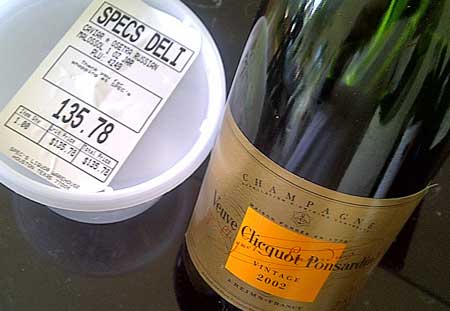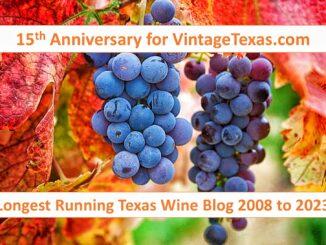Sunday ‘Cyclopedia of Wine: New Year’s Pairing – Champagne and Caviar
If you’re like me, you’ve just celebrated in the new year with a pop of the cork: the cork on a bottle of Champagne, that is. My selection was Veuve Clicquot Gold Label Vintage Brut 2002; perhaps one of the best recent vintages for Champagne. This Champagne was paired with Russian Osetra Cavier. Both were purchase at Spec’s large Smith Street store in downtown Houston.
This pairing may be considered by some to be one of similarity (expensive and expensive). However, this is actually quite a natural and enjoyable wine and food pairing. The crisp, full body and lush silky quality of vintage Champagne stands up to the complex earthy, oily and sea water flavors of the caviar and the tactile pop of the little fish eggs.
There is another aspect of this Franco-Russian wine and food pairing: culture and cuisine. From the time of Catherine the Great, many influential families imported both the products and personnel — many of which were French — to bring the finest, rarest, and most creative foods to their table. This is nowhere more evident than in the elegant, and bit decadent, repertoire of Franco-Russian chefs of the time. The culinary bond between France and Russia is indisputable. Thus, another reason to pair fine French Champagne and Russian Caviar.
However, you may know all that sparkles is not Champagne. Most wine aficionados by now have been lectured on the differences between Champagne and mere sparkling wine, even if made by the same process.
True Champagne is sparkling wine produced in the delimited region setting on white limestone hills and bisected by the River Marne between Rheims and Epernay that resides about 90 miles northeast of Paris. The grapes of Champagne are only three, one white (Chardonnay) and two red (Pinot Noir and Pinot Meunier), the later two bleed white juice when gently crushed or make a rosé if left briefly on their skins.
The process of making Champagne is known as Méthode Champenoise. It starts after primary fermentation and bottling, and involves a second alcoholic fermentation in the bottle. The secondary fermentation occurs when an addition of yeast and sugar is made and the bottle is temporary capped.
The fermenting bottle of wine is then riddled, a process that involves the inverted bottles being given a slight shake and turn so that the yeast cells (lees) slowly settle in the neck of the wine bottle. The wine is then fermented in this manner until the yeast has consumed all of the sugar and produced the coveted natural “tiny bubbles” of carbon dioxide (CO2). Eventually, the wine in the neck of the bottle is then frozen, the cap removed, and then the pressure in the bottle forces out the lees, and the bottle is quickly corked to maintain the carbonated wine.
Because of the short growing season in the cool climate of northern France, Champagnes tend to be naturally quite acidic. To balance this acidity, some Champagnes receive a dosage of a mixture of base wine and sucrose (sugar) immediately after the lees are removed. Depending on the residual sugar content of the wine, the Champagne will get one of the following designations (residual sugar content shown):
Brut Nature – no added sugar: 0–3 g/L; Extra Brut: 0–6 g/L; Brut: 0–12 g/L; Extra Dry, Extra Sec, Extra Seco: 12–17 g/L; Dry, Sec, Seco: 17–32 g/L; Demi-Sec, Semi-Seco: 32–50 g/L; Doux, Sweet, Dulce: 50+ g/L. This labeling scheme was agreed upon by the EU countries in 2009 and a slightly different system applies to older Champagnes.
One more important point on Champagnes is that most are produced “Non-vintage”, whereby they are a blend of grapes from multiple vintages. With the variable climate of northern France, this tends to produce a consistent product, year after year. In a year when the vintage is particularly good some producers will make a “Vintage Champagne” that is composed of at least 85% of the grapes from vintage year.
“Texas Champagne”…..While I realize that there will never really be a “Texas Champagne”, there have been a series of sparkling wines sold by Texas wineries. Most of these wines, however, have been made from out of state grapes and were made in out of state wineries, as well. The rare exceptions was Moyer Champagne Cellars (New Braunfels, TX). It was started in 1980 (before the days of EU regulations) and operated for a few years. Later, the sparkling wine equipment was taken on by Hill Country Cellars (Cedar Park, TX), but alas, it too succumbed in the later-1990s.
Kim McPherson and his California-winemaker brother have previously made sparkling wines made American Appellation. McPherson Cellars (Lubbock, TX) now offers a non-vintage American Sparkling Wine comprised of 50% Chenin Blanc and 50% French Colombard. This blended sparkler was crafted to highlight the fruit qualities of each grape variety and with bright acidity and a delicate sweetness.
I recently sampled a bottle of what I felt illustrated the future of Texas sparkling wines. It was a sparkling wine from Texas’s own grape, Blanc Du Bois, and was made by Les Constable at his Brushy Creek Vineyards (Alvord, TX). I highlighted this wine as one of my honorable mentions for 2010. See my comments below:
Brushy Creek Vineyards, Sparkling Blanc Du Bois, Texas 2009
Texas can now legally lay claim to Blanc Du Bois as its own grape. There is more of it grown in Texas than anywhere else in the whole dang world and winemakers have learned the necessary harvest and process parameters that make Blanc Du Bois into a wide variety of world-class wines and in a variety of styles, too. Here is a new one. Les Constable at Brushy Creek Vineyards (Alvord, TX) has been experimenting with making sparkling Texas wines (actually made here, from Texas-grown grapes and not imported from wineries in California or New Mexico). This Sparkling Blanc Du Bois is Texas’s answer to Italy’s Asti Spumante. It’s semi-sweet and effervescent, fun and friendly. It’s like a sparkling fruit cocktail. I hope Les makes more in 2010 and others like Haak Vineyards, Tara Vineyard and Enoch’s Stomp will follow.
— — — — —
Click link for more on the Edible Texas Wine and Food Pairing Competition (the first of its kind) and the call for entries. Wine and Food can be fun!



Wow! You had a great New Year’s Eve. Veuve Clicquot is a favorite of mine; the NV Rose is the best value in the Champagne category, for complexity and depth of flavor it is remarkable. It is like a magic trick, it tastes just like a Pinot Noir with raspberry cranberry fruit, mushroom and earthiness and the finish is QUICK! It is like it vanishes. Then you need to take another taste.
Having said all that we spent our New Year’s Eve with Dom Perignon and Andy Warhol! Dom Perignon has a tribute label to Mr. Warhol and at Francesca’s at Sunset we took it to the nth degree. Chef Estrada made a fantastic Pop Art inspired menu and we transformed our restaurant into the famous “Factory” art studio. Everyone had a lot of fun. You can see more about it at http://famousatfrancescas.blogspot.com/
Cheers! 2011 will be another Great year for Texas Wine!
Another interesting tasting notes are about the Champagne Dom Perignon which represents all over the world this French maison.
MOËT ET CHANDON À EPERNAY FONDÉE EN 1743 CHAMPAGNE DOM PÉRIGNON BRUT MILLESIME – VINTAGE 1996 12,5%
Grape Blend: chardonnay 52%, pinot noir 48%
VISUAL ANALYSIS: brilliant, intense straw yellow and as regards the effervescence the bubbles are fine, numerous and persistent.
OLFACTORY ANALYSIS: this sparkling wine starts with some sundry smells such as butter, yeast and bread crust; the second scents are represented by peach, lemon, apricot, cedar, lime, nut and the third ones are flint, cinnamon, white chocolate, tomato leaf, sweet majoram and wild flowers. The olfactory bouquet is something that never ceases to amaze the drinker.
GUSTATIVE ANALYSIS: the elegance of this champagne is given us by the exotic fruit of chardonnay grapes; a pleasant salivation is flooding the lateral zones of the palate and a good presence of mineral salts is perceptible in the central zones of the tongue. The gustative persistence is about 5 seconds and the final is lemon and vanilla flavoured.
WINE-FOOD COMBINATION: Parma ham
* The acidity (salivation) of the wine is cutting through the fatness of the ham
* The sapidity (mineral salts) of the wine is counterbalancing by the sweet tendency of the ham
* The structure of the champagne is pairing the structure of the ham
* The gustative-aromatic persistence of the wine is matching the gustative-olfactory persistence of the ham
MY PERSONAL OPINION: the light of this champagne is sparkling with joy and the columns of bubbles are like bright points which define the brilliance in the flute; at the nose, the fragrances are following the hierarchy of the perfume families of the Champagne region, that’s to say: lemon, sweet spices, yeasts, cream or chocolate and biscuits. The best gustative beatification is discoverable at the mouth where the softness, the elegance and the style are playing a fundamental role in developing the excellent characteristics at the palate level.
Guglielmo,
Great work. Your website is one of the most rigorous on food and wine pairing that i’ve seen.
I personally like your style of describing the food and wine experience. It’s extensive and detailed. Some might find it a bit excessive, but hey, let them find their own style.
I thought that the 2002 vintage was a great one. But, the 1996 was outstanding. I tend to prefer vintage Champagne as it manifests the depth of flavor that I prefer. See comments below from Steve Kruger (Westin La Canterra Resort).
Thanks for sharing your comments.
Russ
My wife and I were left to fend for ourselves since our foodie friends were either sick, on cruise or otherwise traveling.
I agree with you on the depth of flavor in the Veuve Clicquot. The 2002 Vintage Champage had it in spades.
Your festivities were grand as well. I love the food foots at:http://famousatfrancescas.blogspot.com … too cool!
May you have a happy and prosperous new year.